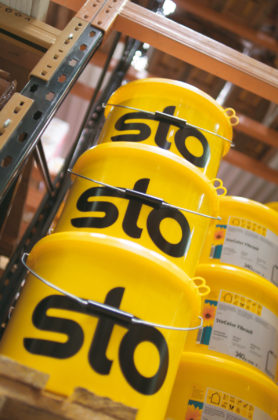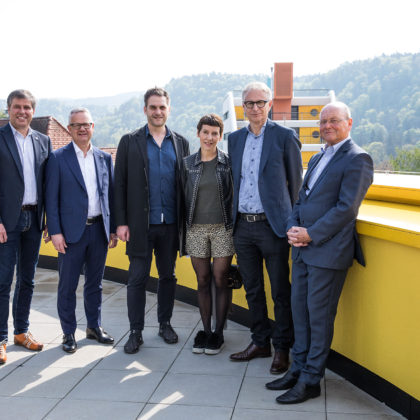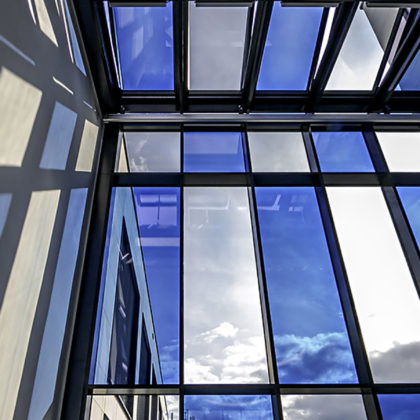![]() Die Meldung steht für Sie auch als Textdokument zum Download bereit.
Die Meldung steht für Sie auch als Textdokument zum Download bereit.
PV modules on the roof and facade supplying power for living and driving
A building that produces more energy than it consumes: the Efficiency House Plus shows that it is possible to build detached houses that can function as miniature power stations. Power is supplied by the photovoltaic modules that are installed not only on the roof but also on the facade (StoVentec ARTline Invisible). They generate so much energy that the research and model project also doubles as a charging station for electric vehicles. The sustainable approach adopted even looks beyond the useful life of the building, as every single part of it can be recycled. It is currently home to a family of four.
Jörg Welke und Simone Wiechers look out through the full-surface glass facade of their living room onto a small garden which is bordered by a four-storey administrative building. When they and their children leave the building through the front door, they face the Berlin University of the Arts. The location of the family’s temporary home alone gives away the fact that this is not a normal house: they live in the Efficiency House Plus, a building erected as part of the “Zukunft Bau” building for the future initiative launched by the Federal Ministry of Transport, Building and Urban Development. The design for the research and model project came from a working party collaboration between the Institute for Lightweight Structures and Conceptual Design (ILEK) at the University of Stuttgart and Werner Sobek’s office. The aim was to build a house that would produce more energy than it consumed during the course of the year. The design also aimed at demonstrating the potential that could be tapped into by bringing together electric mobility and energy-efficient construction: the excess energy can be used to power an electric vehicle, for example. The power demand of the house, including the charging station, was forecast to be approximately 15,400 kWh/year, whilst the power yield was estimated at 16,630 kWh/year.
In order to check whether these values were realistic, the Ministry looked for a family of four to inhabit the house. They will live in the 135-m² house until July 2013. It is instantly clear from the entrance side of the house (which doubles as a shop window showcasing the technical components that are key to how the house operates) that living here is like living in a goldfish bowl. It is not only on the roof that sunlight is converted into electrical energy: the entire south-west facade is made up of thin-layer photovoltaic modules installed as a ventilated rainscreen facade system with concealed fixing (StoVentec ARTline Invisible). For a harmonised appearance, the planners also selected a ventilated rainscreen facade system with concealed fixing (StoVentec Glass) for the north-east side, featuring opaque black glass panels. The front and garden sides of the house are characterised by transparent facades with triple insulation glazing. Amongst others, the energy generated by the house is used for lighting and to run household appliances. A heat pump warms the heating system and heats the tap water. But as well as impressing with its intelligence, the building has a sustainable design: once the test phase is completed, the house can be taken down and rebuilt somewhere else. Furthermore, at the end of its useful life, it can be completely recycled.
Building owner:
Federal Ministry of Transport, Building and Urban Development, Berlin
Architect:
Werner Sobek, Stuttgart
Location:
Fasanenstraße, Berlin
Sto expertise:
ventilated rainscreen Photovoltaic facade system (StoVentec ARTline Invisible)
Tradesmen:
Projekt Holzbau Erkle, Bissingen unter Teck
 |
Entrance area: both shop window and fuelling station. The unusual appearance of the house attracts the attention of passers-by.
Photo: Matthias Koslik, Berlin / Sto AG
|
||
 |
The facade is covered with thin-layer photovoltaic modules. It makes a significant contribution to the calculated power yield of approx. 16,630 kWh/year.
Photo: Matthias Koslik, Berlin / Sto AG
|
||
 |
A building automation system processes all measured data centrally and makes it available for an openly programmable system.
Photo: Ulrich Schwarz, Berlin, / Sto AG
|
||
 |
View of the entrance area of the house, which is being tested until July 2013.
Photo: Ulrich Schwarz, Berlin, / Sto AG
|
||
 |
An inductive field is used to charge the electric vehicle in front of the street-facing facade.
Photo: Ulrich Schwarz, Berlin, / Sto AG
|
||
Publication free of charge, specimen copy requested



